Sweet Corn
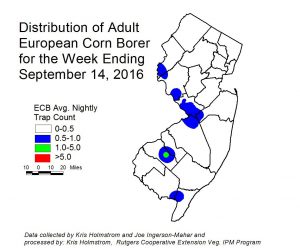 European corn borer (ECB) moth numbers increased slightly this past week. At the present time, highest activity is in western areas from the Delaware Bay shore northward to Warren County (see ECB map). This partial third flight should not present much of a threat to host crops. This is particularly true in light of the dominance this year of fall armyworm (FAW). FAW will probably remain the larger threat, and treatments for this pest will eliminate ECB in the process. See the 2016 Commercial Vegetable Recommendations Guide for insecticide choices.
European corn borer (ECB) moth numbers increased slightly this past week. At the present time, highest activity is in western areas from the Delaware Bay shore northward to Warren County (see ECB map). This partial third flight should not present much of a threat to host crops. This is particularly true in light of the dominance this year of fall armyworm (FAW). FAW will probably remain the larger threat, and treatments for this pest will eliminate ECB in the process. See the 2016 Commercial Vegetable Recommendations Guide for insecticide choices.
The highest nightly ECB catches for the previous week are as follows:
| Allentown 1 | Lawrenceville 1 |
| Crosswicks 1 | Pennington 1 |
| Downer 1 | Phillipsburg 1 |
| Georgetown 1 | Sergeantsville 1 |
There has been little change in the fall armyworm (FAW) situation in the north and central areas. Joe Ingerson-Mahar indicates that re-infestation rates in younger corn in the southern counties have declined somewhat. Infestations continue throughout NJ, with damaging infestation rates in all parts of the state. We should expect this pest to be with us for the remainder of the sweet corn growing season. Treat when FAW alone or in combination with ECB damage exceeds 12% plants infested. FAW do not respond well to pyrethroid insecticides. The most useful products are those in the IRAC group 28 class (Coragen, Exirel) or the IRAC group 5 class (Radiant, Entrust), or combination products including these classes. See the 2016 Commercial Vegetable Recommendations Guide for insecticides effective against FAW.
 Corn earworm moth (CEW) activity has increased somewhat in the southern and eastern parts of the state over the past week (see CEW map). Elsewhere, the situation is largely unchanged. Exceptionally high temperatures over the weekend may have resulted in increased activity. Weekly averages remain moderately high. It is advisable to incorporate materials into the spray program that have different modes of action from the pyrethroids. This includes IRAC 28 materials like Coragen, Exirel and Besiege, as well as IRAC 5 (Radiant, Entrust (OMRI approved), and Blackhawk)). Our current population is still lower than we traditionally get in mid-August. Growers should be checking CEW activity frequently, and adjust spray schedules according to local activity.
Corn earworm moth (CEW) activity has increased somewhat in the southern and eastern parts of the state over the past week (see CEW map). Elsewhere, the situation is largely unchanged. Exceptionally high temperatures over the weekend may have resulted in increased activity. Weekly averages remain moderately high. It is advisable to incorporate materials into the spray program that have different modes of action from the pyrethroids. This includes IRAC 28 materials like Coragen, Exirel and Besiege, as well as IRAC 5 (Radiant, Entrust (OMRI approved), and Blackhawk)). Our current population is still lower than we traditionally get in mid-August. Growers should be checking CEW activity frequently, and adjust spray schedules according to local activity.
The highest nightly CEW catches for the previous week are as follows:
| New Egypt 16 | Georgetown 6 | Green Creek 4 |
| Jones Island 10 | Medford 5 | Pedricktown 4 |
| Tabernacle 7 | Beckett 4 | Allentown 3 |
| East Vineland 6 | Cinnaminson 4 | Old Bridge 2 |
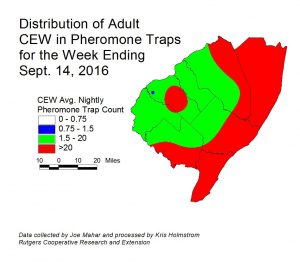 The limited CEW pheromone trap network registered increased catches in the eastern portion of south Jersey over the past week. Significant CEW moth populations are present throughout southern NJ (see CEW pheromone map). The low number of traps results in broad areas of color within the map. It is critical that growers monitor local CEW moth numbers. At present, this population constitutes a significant threat to silking corn.
The limited CEW pheromone trap network registered increased catches in the eastern portion of south Jersey over the past week. Significant CEW moth populations are present throughout southern NJ (see CEW pheromone map). The low number of traps results in broad areas of color within the map. It is critical that growers monitor local CEW moth numbers. At present, this population constitutes a significant threat to silking corn.
The highest nightly CEW pheromone trap catches for the previous week are as follows:
| Green Creek 148 | Berlin 20 | Springdale 8 |
| Jobstown 38 | Woodstown 11 | |
| Monroeville 36 | East Vineland 9 |
For silking sweet corn, the following spray schedules are warranted.
Silking Spray Schedules*:
South – 3 days
Central – 3 days
North – 3-4 days
*These recommendations are based on regional catches.
Brown Marmorated Stinkbug (BMSB)
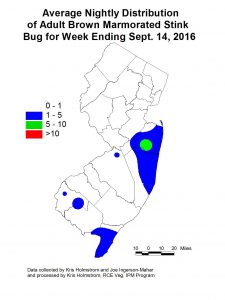 BMSB numbers rose again sporadically, in NJ blacklight traps this past week. Highest activity was in eastern parts of NJ (see BMSB map). This is the time of the summer when BMSB catches in light traps generally decline, while increasing in pheromone traps as the bugs begin to aggregate. The fruit IPM Program reports that bugs are now moving into apple orchards, where they are capable of causing significant fruit injury.
BMSB numbers rose again sporadically, in NJ blacklight traps this past week. Highest activity was in eastern parts of NJ (see BMSB map). This is the time of the summer when BMSB catches in light traps generally decline, while increasing in pheromone traps as the bugs begin to aggregate. The fruit IPM Program reports that bugs are now moving into apple orchards, where they are capable of causing significant fruit injury.
Pumpkins and Winter Squash
Down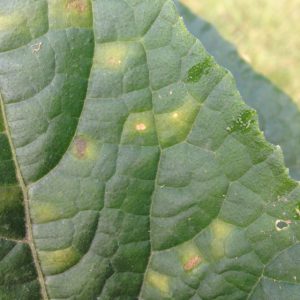 y mildew (DM) is present on cucumbers in all parts of NJ (see photo at left). All growers should be applying appropriate protectant fungicides plus DM specific materials to cucumbers and cantaloupes at this time, and scouting frequently and preparing to make DM applications on pumpkins and winter squash. As of 9/14/16, RCE personnel have still not been able to confirm DM on
y mildew (DM) is present on cucumbers in all parts of NJ (see photo at left). All growers should be applying appropriate protectant fungicides plus DM specific materials to cucumbers and cantaloupes at this time, and scouting frequently and preparing to make DM applications on pumpkins and winter squash. As of 9/14/16, RCE personnel have still not been able to confirm DM on 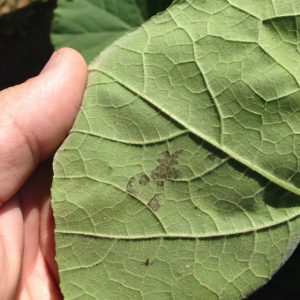 crops other than cucumber, and the only crop in the DM sentinel plot at Snyder Research Farm in Hunterdon county that is infected is cucumber. DM lesions appear as yellow areas on the upper leaf surface with leaf veins making distinct borders to the lesions. On the lower leaf surface, beneath the lesions, dark spores may be seen if conditions are moist (see photo at right). For more information on the regional presence of DM as well as comprehensive, weekly forecasts, see the following website: http://cdm.ipmpipe.org. At this time, with the current weather pattern, NJ is at low risk of new infections according to the Cucurbit Downy Mildew Forecast.
crops other than cucumber, and the only crop in the DM sentinel plot at Snyder Research Farm in Hunterdon county that is infected is cucumber. DM lesions appear as yellow areas on the upper leaf surface with leaf veins making distinct borders to the lesions. On the lower leaf surface, beneath the lesions, dark spores may be seen if conditions are moist (see photo at right). For more information on the regional presence of DM as well as comprehensive, weekly forecasts, see the following website: http://cdm.ipmpipe.org. At this time, with the current weather pattern, NJ is at low risk of new infections according to the Cucurbit Downy Mildew Forecast.
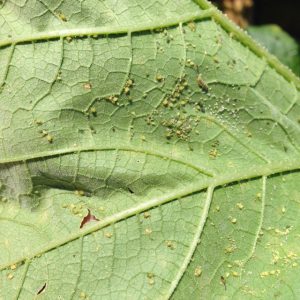 At this time, it is important to check fields for the presence of melon aphid (see photo at left). This pest is capable of producing sticky droppings that can accumulate on the surface of fruit. This condition is unsightly, especially in u-pick situations. Melon aphid is somewhat difficult to control, and applications of synthetic pyrethroids will make the situation worse. Consider treating if melon aphid colonies are found in more than one site in ten. Newer materials such as Fulfill, Sivanto and Movento are more useful. See the 2016 Commercial Vegetable Production Recommendations for more options.
At this time, it is important to check fields for the presence of melon aphid (see photo at left). This pest is capable of producing sticky droppings that can accumulate on the surface of fruit. This condition is unsightly, especially in u-pick situations. Melon aphid is somewhat difficult to control, and applications of synthetic pyrethroids will make the situation worse. Consider treating if melon aphid colonies are found in more than one site in ten. Newer materials such as Fulfill, Sivanto and Movento are more useful. See the 2016 Commercial Vegetable Production Recommendations for more options.
Tomatoes
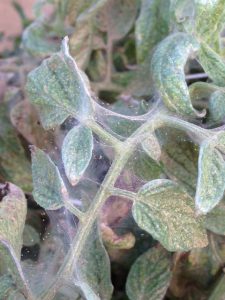 Two-spotted spider mite (TSSM) continues to be found in scouted fields. This pest is particularly favored by the heat we continue to experience. Check fields regularly for the appearance of yellowing on leaves, whitish pin-spots or the presence of webbing (photo at right). All are indications that TSSM may be present. If TSSM is present, the actual mites will be found on the lower leaf surface. It is best to treat for TSSM before the population gets too widespread. Spot treatments may be adequate to achieve satisfactory control. There are a number of good miticides available, and growers should choose products based on efficacy and pre-harvest interval. See the 2016 Commercial Vegetable Recommendations Guide for miticides effective against TSSM.
Two-spotted spider mite (TSSM) continues to be found in scouted fields. This pest is particularly favored by the heat we continue to experience. Check fields regularly for the appearance of yellowing on leaves, whitish pin-spots or the presence of webbing (photo at right). All are indications that TSSM may be present. If TSSM is present, the actual mites will be found on the lower leaf surface. It is best to treat for TSSM before the population gets too widespread. Spot treatments may be adequate to achieve satisfactory control. There are a number of good miticides available, and growers should choose products based on efficacy and pre-harvest interval. See the 2016 Commercial Vegetable Recommendations Guide for miticides effective against TSSM.
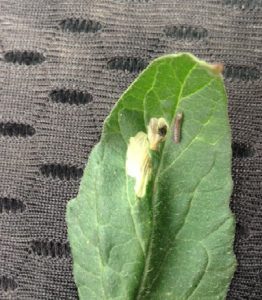 Tomato pinworm is bring discovered in more areas of western NJ. This pest initially causes mines on leaves (see photo at left), and as the larva (a caterpillar) outgrows the leaf, it tunnels into fruit beneath the calyx. Pinworm had begun to appear with some regularity three seasons ago, following mild winters. The harsh winters of the intervening years seemed to stop it. However, the presence of this pest, following another mild winter is an indication that we need to be vigilant for its’ reappearance next year. Pinworm can be managed effectively with several materials, including Coragen, either as a foliar application or through the drip system. See the 2016 Commercial Vegetable Recommendations Guide for other options. It is critical, however, that this pest be managed when mines are first noticed, rather than when fruit become infested.
Tomato pinworm is bring discovered in more areas of western NJ. This pest initially causes mines on leaves (see photo at left), and as the larva (a caterpillar) outgrows the leaf, it tunnels into fruit beneath the calyx. Pinworm had begun to appear with some regularity three seasons ago, following mild winters. The harsh winters of the intervening years seemed to stop it. However, the presence of this pest, following another mild winter is an indication that we need to be vigilant for its’ reappearance next year. Pinworm can be managed effectively with several materials, including Coragen, either as a foliar application or through the drip system. See the 2016 Commercial Vegetable Recommendations Guide for other options. It is critical, however, that this pest be managed when mines are first noticed, rather than when fruit become infested.
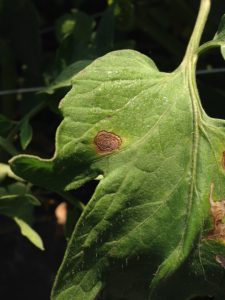 As nights lengthen, and dews are heavier and longer, early blight (see photo at right) can increase dramatically. Be sure to be on a strict protectant fungicide program to preserve foliage into the later part of the season. Early blight (alternaria) generally attacks mature foliage first, but if not managed, it can move up the plant rapidly. Several fungicides and appropriate rotations are found in the 2016 Commercial Vegetable Recommendations Guide.
As nights lengthen, and dews are heavier and longer, early blight (see photo at right) can increase dramatically. Be sure to be on a strict protectant fungicide program to preserve foliage into the later part of the season. Early blight (alternaria) generally attacks mature foliage first, but if not managed, it can move up the plant rapidly. Several fungicides and appropriate rotations are found in the 2016 Commercial Vegetable Recommendations Guide.
Pepper weevil
No weevils were caught in the traps this past week. However one field in the Swedesboro area was found with a light infestation (Ed Gunther, Crop Production Services). Where the weevils came from remains unknown. Weevil infestations occurring this late in the season will cause little yield loss and may not be economical to treat.
Cole Crops
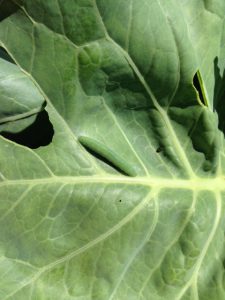
 These crops are being attacked by a variety of caterpillar pests now, including imported cabbageworm (ICW) (see photo at far right), diamondback moth larvae, cabbage loopers, cross striped cabbageworm and in some cases, beet armyworm. Of all of these pests, ICW does the most immediate damage to developing tissue (see photo at near right). Be sure to look at the interior portions of all plants. Sample 5 consecutive plants each, in 10 sites. If the number of infested plants with any larvae is above 5% with heads present, or >20% before head formation, consider treating. In leafy greens, consider treating if infested plants exceed 10%.
These crops are being attacked by a variety of caterpillar pests now, including imported cabbageworm (ICW) (see photo at far right), diamondback moth larvae, cabbage loopers, cross striped cabbageworm and in some cases, beet armyworm. Of all of these pests, ICW does the most immediate damage to developing tissue (see photo at near right). Be sure to look at the interior portions of all plants. Sample 5 consecutive plants each, in 10 sites. If the number of infested plants with any larvae is above 5% with heads present, or >20% before head formation, consider treating. In leafy greens, consider treating if infested plants exceed 10%.

